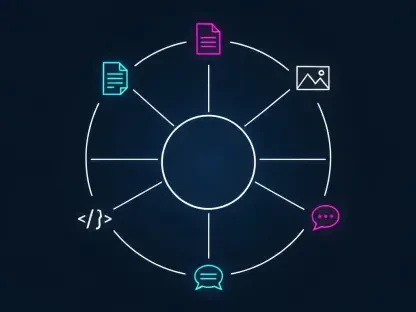Oscar Vail, a leading expert in technology with a fascination for quantum computing, robotics, and open-source initiatives, joins us for an insightful discussion about AI tools like ChatGPT. Vail has a deep understanding of how these technologies can transform industries and individual experiences. His hands-on expertise provides a valuable perspective on navigating the rapidly evolving digital landscape.
How does ChatGPT work at its core?
At its essence, ChatGPT operates as a large language model that uses deep learning techniques to generate text. It’s a sophisticated prediction machine that processes input and predicts the next probable word, ensuring coherence and relevance in conversation. This predictive nature makes it versatile and capable of handling diverse tasks, from generating creative content to assisting in technical queries.
What is meant by the term “hallucination” in AI tools like ChatGPT?
AI hallucination refers to instances where tools like ChatGPT generate false or misleading information. As the model predicts text rather than retrieving factual data, it can sometimes fabricate details, especially if the prompts are suggestive or incomplete. Recognizing this limitation is crucial for users to critically evaluate AI-produced content for accuracy.
Why is it recommended to treat ChatGPT’s responses as first drafts?
Treating responses as first drafts acknowledges the tool’s predictive nature, which can produce content that’s not entirely precise. This approach allows users to refine and verify information, using ChatGPT as a starting point. By doing so, users can ensure that the final output is both accurate and tailored to their needs.
How can shifting your mindset improve the results you get from ChatGPT?
Adapting your mindset is key to leveraging ChatGPT effectively. Embracing its ability to provide different perspectives, challenging your biases, and initiating a dialogue for feedback can expand your understanding. Approaching it as a collaborative partner encourages more nuanced interactions and enhances the quality of output.
How can you use ChatGPT to challenge your own biases?
To challenge biases, users can prompt ChatGPT to present views contrary to their own or act as a devil’s advocate. By requesting counterarguments or alternative interpretations, users can broaden their thinking and explore diverse viewpoints, thus enriching their understanding of complex topics.
What are some strategies to get ChatGPT to provide different perspectives?
A useful strategy is to ask open-ended questions or frame prompts that invite diverse thoughts. Requesting the AI to emulate experts or thinkers from various fields can shift its focus, generating multi-faceted insights. Specifying the perspective you wish to explore can also guide the AI to challenge conventional ideas.
How does the clarity of your input affect ChatGPT’s output?
Clear input significantly influences output quality. Precise prompts, detailing desired format, tone, and audience, align the AI’s responses with the user’s expectations. By eliminating ambiguity, users ensure the tool generates content that is both relevant and valuable.
Can you give an example of a detailed prompt that might yield better results?
Consider a prompt like, “Draft a 500-word article on AI in education for middle school teachers, with a focus on hands-on implementation and engaging narratives.” This specificity guides the AI in producing content that resonates with the intended audience and purpose, resulting in more effective communication.
How can directing ChatGPT to “act as” a specific role improve interactions?
Directing ChatGPT to assume a particular role can steer the conversation toward specialized knowledge and context, making interactions more fruitful. This technique helps tailor responses to align with user needs, enhancing the AI’s effectiveness in producing content that mirrors real-world expertise.
What should you keep in mind when asking ChatGPT to take on a specific role?
It’s important to remember that, despite adopting roles, ChatGPT lacks genuine expertise. Users should guide its output with clear and structured prompts and remind themselves of the AI’s limitations to prevent over-reliance on its interpretations or advice.
In what ways is ChatGPT most helpful as a brainstorming partner?
ChatGPT excels at generating ideas, organizing thoughts, and overcoming creative blocks. It provides initial concepts that users can refine and develop, fostering creativity and innovation by offering diverse angles and encouraging outside-the-box thinking.
What responsibilities remain with the user when collaborating with ChatGPT?
Users retain the responsibility of verifying information, ensuring content alignment with personal or organizational standards, and making creative judgments. They must guide the AI’s influence to maintain integrity and relevance, acknowledging that the final output is a product of their input and oversight.
Why is it important to remember that ChatGPT is not a human advisor or friend?
Recognizing ChatGPT’s non-human nature prevents emotional dependency and over-trust in its answers. It remains a tool—a system for text generation devoid of personal insight or empathy—and should complement rather than replace human judgment and decision-making.
How can over-relying on ChatGPT for feedback lead to potential pitfalls?
Excessive reliance might result in accepting information without scrutiny, diminishing critical thinking. This dependence may blur the line between reliable advice and AI-generated predictions, leading to misinformation or a skewed understanding of topics.
What future applications of AI like ChatGPT do you find most intriguing?
The possibility of integrating AI with educational platforms for personalized learning excites me. Additionally, its role in healthcare for patient interaction or as an aid in creative industries to push artistic boundaries showcases extraordinary potential. AI’s continued evolution will reshape how we approach human-machine collaboration.
How do you perceive the ethical considerations of AI development?
Ethical considerations are paramount. Ensuring transparency, preventing bias, and safeguarding privacy must be prioritized. AI developers should remain vigilant about potential misuse and constantly assess societal impacts to balance innovation with responsible stewardship.
Do you have any advice for our readers?
My advice would be to approach AI as a complementary tool, recognizing its capabilities and limitations. Cultivate a curious mindset, engage critically with AI outputs, and always be ready to learn and adapt as technology evolves. Embrace the possibilities but retain a discerning approach to its applications.









